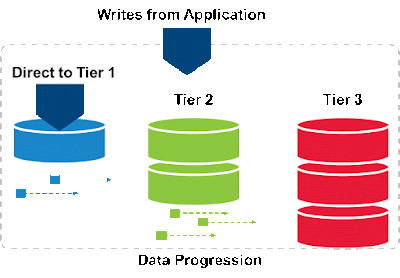Twitter Feed
2018 AT&T Business Summit: Security “in” and “of” the Cloud
While public cloud is undoubtedly an outsized piece of the conversation, news headlines of the latest data breach can make this move a very frightening proposition. The question of how…
My Brush with Royalty: Queen Latifah
Queen Latifah! Hip Hop Icon. Movie Star. Television Star. Fashion Model. Songwriter. Producer. Entrepreneurial Genius!? YES! Dana Elaine Owens, her given name, is co-owner of Flavor Unit Entertainment, a firm that includes…
What’s New in Puppet 5?
Puppet 5 is released and comes with several exciting enhancements and features that promise to make configuration management much more streamlined. This article will take a comprehensive look at these…
5 Reasons Why Ansible is the Best CM Tool Out There?
Amidst volatile markets, dynamic technology shifts, and ever-increasing customer demands, it is imperative for IT organizations to develop flexible, scalable and high-quality applications that exceed expectations and enhance productivity. A…
Machine learning APIs for Google Cloud Platform
Google Cloud Platform (GCP) is considered to be one of the Big 3 cloud platforms among Microsoft Azure and AWS. GCP is widely used cloud solutions supporting AI capabilities to design and…
What Is The Most Important Part of Architecture?
I always find it interesting to hear what people view architecture as. A lot of people think it’s just about the design aspect, where you get to put pen to…
Cloud migration best practice Part 4: Executing the migration
This series has stepped through cloud migration best practices. After providing an overview, we discussed: Classifying business-critical data. Updating organizational IT governance policies. Application screening and cloud workload selection. How to…
Cloud Migration Best Practice Part 3: Application Portfolio Analysis
In part three of this series on cloud migration best practice, I will focus on migrating the application itself. If you haven’t had the opportunity to read our recommendations from part…
Why Use Immutable Storage?
Data has become a global currency, and its value has nowhere to go but up. According to The Economist online, the world’s most valuable resource is no longer oil, but…
CLOUD ACT: What Does That Mean for Your Cloud Storage
When Congress names a law after you, it’s getting serious. That is where we are now with cloud computing. The Clarifying Lawful Overseas Use of Data Act or CLOUD Act (H.R. 4943) is…
Enterprise storage is trending away from traditional, enterprise managed network-attached storage (NAS) and storage area networks (SAN) towards a more complex environment that includes software-defined and cloud-based solutions. Spinning disks are also being replaced with flash arrays and solid state devices. These transformations are driven by challenges associated with the parallel processing of unstructured data within a near-real-time business operational tempo. Technology advances that exemplify this transition include:
- Big Data – The analysis, capture, data curation, search, sharing, storage, transfer, visualization, querying and information privacy of extremely large, complex and unstructured data sets.
- Enterprise Applications – Business applications characterized by their complexity, scalability requirements, distributed and component-based architecture and mission-critical nature (especially CRM and ERP).
- Microservices – The creation and delivery of software application functionality as a suite of services instead of as a tightly coupled monolith of software code.
- Containers – Operating system level virtualization in which the virtualization layer runs as an application within the operating system. In this approach, the operating system’s kernel runs on the hardware node with several isolated guest virtual machines installed on top of it.
- Social Networking – web-based services that allow individuals to create a public profile, create a list of users with whom to share connections, view, and cross the connections within the system. These platforms are used to build social networks or social relations among people and organizations that share similar interests, activities, backgrounds or real-life connections.
In revolutionizing business models everywhere, these advances are also driving unimagined changes in how businesses use the underlying data. According to Forrester Research, however, 85 percent of production data is inactive and 68 percent of this data is not even accessed for over 90 days. IDC actually enhances the view of operational business data by reporting only 10-20 percent of a company’s data is being actively used and the rest is “cold” data.
These statistics describes an enterprise environment that demands heavy and time-sensitive use of recently acquired data. From an economic viewpoint, storage is, in fact, one of the largest single costs in the data center. “About five years ago, storage represented about 20 percent worth of the cost of a fully loaded computing stack. Last year in 2015, it represented about 40 percent of the computing stack thanks to factors like machine-generated and mobile data.” The demands introduced by this sort of environment is why hybrid storage arrays have become popular. This approach to enterprise storage delivers a crucial “middle ground” solution between high speed/high cost solid-state storage pools and more economical hard disk based resources. In doing so, it enables the use of a more optimal 3-tier storage architecture capable of near-real-time optimization across the disparate demand of multiple enterprise application.
 |
|
Figure 1– Comparative cost of storage technologies
|
This trend also lends credence to a belief that the 2020 IT infrastructures will be underpinned by storage technologies that can support software-defined management of multiple storage pools across a hybrid IT landscape. New approaches to application virtualization are also having a revolutionizing effect on the use of data storage. Operational requirements for big data analytics on unstructured data
is driving the adoption of “application specific storage architectures” and real-time storage configurability. Tiering is also an enabler for the adoption and efficient operational deployment of container and microservice technologies. This reality presents a compelling case for rapid enterprise adoption of advanced tiered storage architectures.
When selecting storage technologies, the smart money goes to those solutions that support the industry’s need for high performance and economical high density online storage. In order to enable the highest degree of storage automation, the solution should be able to manage the various storage technologies through a consistent interface or API. These minimum requirements provide the dynamism necessary for handling the self-assembling microservice applications of the very near future.
 |
|
Figure 2– 3-Tier storage architecture enables near-real-time optimization across the disparate demands of multiple enterprise applications
|
Wheeling Hospital is an example of the importance of having a modern storage strategy. By upgrading to a more modern storage platform, they were able to dramatically improve the performance of its clinical information system. The hospital cut backup time in half and achieved a 40 percent increase in database performance by using the Dell Compellent flash-optimized array and Dell Networking switches. Moreover, the hospital was able to easily upgrade to the latest version of their clinical information system because of the additional capacity and performance it is receiving from the Dell solution.
 |
(This post was written as part of the Dell Insight Partners program, which provides news and analysis about the evolving world of tech. Dell sponsored this article, but the opinions are my own and don’t necessarily represent Dell’s positions or strategies.)
( Thank you. If you enjoyed this article, get free updates by email or RSS – © Copyright Kevin L. Jackson 2015)
Cloud Computing
- CPUcoin Expands CPU/GPU Power Sharing with Cudo Ventures Enterprise Network Partnership
- CPUcoin Expands CPU/GPU Power Sharing with Cudo Ventures Enterprise Network Partnership
- Route1 Announces Q2 2019 Financial Results
- CPUcoin Expands CPU/GPU Power Sharing with Cudo Ventures Enterprise Network Partnership
- ChannelAdvisor to Present at the D.A. Davidson 18th Annual Technology Conference
Cybersecurity
- Route1 Announces Q2 2019 Financial Results
- FIRST US BANCSHARES, INC. DECLARES CASH DIVIDEND
- Business Continuity Management Planning Solution Market is Expected to Grow ~ US$ 1.6 Bn by the end of 2029 - PMR
- Atos delivers Quantum-Learning-as-a-Service to Xofia to enable artificial intelligence solutions
- New Ares IoT Botnet discovered on Android OS based Set-Top Boxes



